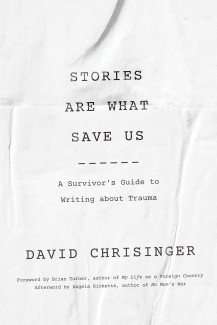
Johns Hopkins UniversityEst. 1876
America’s First Research University
Now Browsing:
What Even Is Trauma?

Trauma was the word of the year in 2018, according to the Oxford Dictionary. That was the same year I decided my tenure working as a communications specialist in the federal government needed to end. I felt I had achieved all I was going to, and that it was time to spend more time teaching a new generation of policy analysts to write public policy stories that matter.
In February 2019, I took over the direction of the writing program (if we can call it that) at the University of Chicago's Harris School of Public Policy. One of the many things I quickly found the students wanted help with was figuring out effective ways to talk about traumatic things, whether it's war, natural disaster, police brutality, or whatever else. They wanted help making sense of their stories so that they could hopefully better understand other people's stories, too.
One question I've gotten several times since my latest book, Stories Are What Save Us: A Survivor's Guide to Writing about Trauma, is what even is trauma? It has to have something to do with post-traumatic stress, for sure. But what if you experience something—or do something—that others may not perceive as traumatic? Is that a story worth telling?
The short answer is: Yes. Absolutely.
As to what even is trauma, for years I have ascribed to the way the brilliant Judith Herman defines trauma. “Unlike commonplace misfortune," she writes, "traumatic events generally involve threats to life or bodily integrity, or a close personal encounter with violence and death. They confront human beings with the extremities of helplessness and terror, and evoke the response of catastrophe.”

But even that definition feels incomplete to me. According to Dr. Harold Kudler, a professor of psychiatry at the Duke University School of Medicine, we as a society have no idea what trauma is. Nobody, he says, seems to agree on what makes up terror, and some experts have rejected entirely the idea that at least some forms of trauma are fear-based.
And in its fifth edition, the Diagnostic and Statistical Manual of Mental Disorders added that someone could develop post-traumatic stress if they were exposed to possible death, either directly or indirectly. In other words, the aperture in which we view trauma continues to expand.
The truth is that the types of trauma that can be experienced are far more diverse than we've previously recognized, and they involve a much wider range of emotions at the time of the trauma that we originally believed. And more than that, we're beginning to see the myriad ways in which people react to trauma in its aftermath.
Perhaps the best way to define trauma, given what we know today, is to say that before the trauma there was wholeness; after, there was fracture. Where there was once some semblance of safety and security, dignity and peace, there is now pain and grief, fear and hopelessness.
If you've experienced a trauma, and you want to find a way to wrap your arms around it and communicate what you've learned from your life's hardest battles—whatever they may be—I hope you'll check out my book. And when you're ready, tell your story with confidence and courage. That's the only thing that matters, if you ask me.
Order Stories Are What Save Us: A Survivor's Guide to Writing about Trauma at the following link: https://jhupbooks.press.jhu.edu/title/stories-are-what-save-us
David Chrisinger directs the Harris Writing Program at the University of Chicago as well as The War Horse's writing seminars program, which offers workshops for military veterans and their families. He is the author of Stories Are What Save Us: A Survivor's Guide to Writing about Trauma, Public Policy Writing That Matters, and the editor of See Me for Who I Am: Student Veterans' Stories of War and Coming Home.

In February 2019, I took over the direction of the writing program (if we can call it that) at the University of Chicago's Harris School of Public Policy. One of the many things I quickly found the students wanted help with was figuring out effective ways to talk about traumatic things, whether it's war, natural disaster, police brutality, or whatever else. They wanted help making sense of their stories so that they could hopefully better understand other people's stories, too.
One question I've gotten several times since my latest book, Stories Are What Save Us: A Survivor's Guide to Writing about Trauma, is what even is trauma? It has to have something to do with post-traumatic stress, for sure. But what if you experience something—or do something—that others may not perceive as traumatic? Is that a story worth telling?
The short answer is: Yes. Absolutely.
As to what even is trauma, for years I have ascribed to the way the brilliant Judith Herman defines trauma. “Unlike commonplace misfortune," she writes, "traumatic events generally involve threats to life or bodily integrity, or a close personal encounter with violence and death. They confront human beings with the extremities of helplessness and terror, and evoke the response of catastrophe.”

But even that definition feels incomplete to me. According to Dr. Harold Kudler, a professor of psychiatry at the Duke University School of Medicine, we as a society have no idea what trauma is. Nobody, he says, seems to agree on what makes up terror, and some experts have rejected entirely the idea that at least some forms of trauma are fear-based.
And in its fifth edition, the Diagnostic and Statistical Manual of Mental Disorders added that someone could develop post-traumatic stress if they were exposed to possible death, either directly or indirectly. In other words, the aperture in which we view trauma continues to expand.
The truth is that the types of trauma that can be experienced are far more diverse than we've previously recognized, and they involve a much wider range of emotions at the time of the trauma that we originally believed. And more than that, we're beginning to see the myriad ways in which people react to trauma in its aftermath.
Perhaps the best way to define trauma, given what we know today, is to say that before the trauma there was wholeness; after, there was fracture. Where there was once some semblance of safety and security, dignity and peace, there is now pain and grief, fear and hopelessness.
If you've experienced a trauma, and you want to find a way to wrap your arms around it and communicate what you've learned from your life's hardest battles—whatever they may be—I hope you'll check out my book. And when you're ready, tell your story with confidence and courage. That's the only thing that matters, if you ask me.
Order Stories Are What Save Us: A Survivor's Guide to Writing about Trauma at the following link: https://jhupbooks.press.jhu.edu/title/stories-are-what-save-us
David Chrisinger directs the Harris Writing Program at the University of Chicago as well as The War Horse's writing seminars program, which offers workshops for military veterans and their families. He is the author of Stories Are What Save Us: A Survivor's Guide to Writing about Trauma, Public Policy Writing That Matters, and the editor of See Me for Who I Am: Student Veterans' Stories of War and Coming Home.

Login to View & Leave Comments
Login to View & Leave Comments


